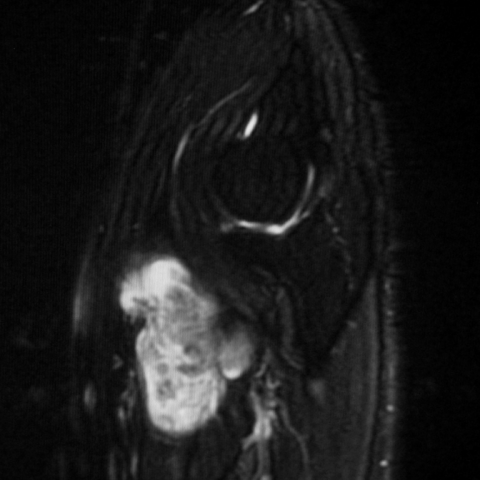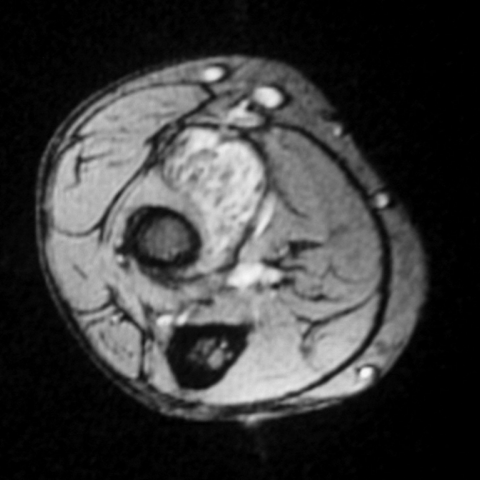


We present the case of a 56 year old woman with a painful mass located in the anterior ulnar fossa of the right elbow with slow growing and 6 months evolution.
There were no traumatic antecedents, nor systemic disease or another joint involvement.
Figure 1: US study, medial sagittal plane. Mixed mass, with a cystic component and a hyperechogenic, fatty, component.
Figure 2: Axial FSE T1 MR image. Mass located between the bicipital tendon and the radius, with a mixed signal, and hyperintense areas corresponding to fatty tissue proliferations.
Figure 3: Sagittal FSE T2, fat suppressed, MR. Mass with a hyperintense fluid component, inner formations of low signal intensity related to fat suppression.
Figure 4: Axial GRE T2* MR. Fluid collection with areas of low signal intensity.
Figure 5: Axial FSE T1, fat suppressed, MR after intravenous contrast administration. Increase of signal intensity of the mass related to synovitis.
Figure 6: Isotopic scan. Increase of vascularity of the radial border of the right forearm in the vascular phase (*) and a slight increase of intake in the osseous phase (→).
Figure 7: Microscopic correlation. Subsynovial proliferations, presence of mature adipocytes (*), chronic inflammatory infiltrates and vascular congestion.
Lipoma arborescens (LA) is a synovial entity that consists of a hyperplastic proliferation of fatty tissue that replaces the subsynovial connective layer, under the form of villous proliferations. It is usually a monoarticular disorder mainly located in the knee with a unilateral form of presentation, which tends to involve the suprapatelar recess and clinically characterized by progressive chronic synovial discharge and painful exacerbations.
The bicipitoradial bursa location of LA is very rare. There are only five previous cases described in the scientific literature. Although some of the LA cases in other different locations from the elbow are related to osteoarthritis or inflammatory arthropathy, in the bicipitoradial location the aetiology is unknown. The chronic synovial inflammation is thought to have a probable traumatic origin, secondary to a repeated friction of the bursa related to the forced pronation of the forearm.
Conventional radiology and CT can show the fatty density of this tumour, but MR is the imaging modality that allows a correct diagnosis of LA, as in our case, when a mass with fatty deposits and a frond-like appearance is identified.
Most cases present a good response to the intraarticular steroid administration, which is used to control the exacerbations, but the most common treatment is the arthroscopic or open synovectomy, as in the case we are dealing with.
Lipoma arborescens of the elbow bicipital bursa







Based on the ultrasound and MRI images, a localized soft tissue mass can be observed in the anterior aspect of the right elbow (anterior ulnar fossa):
Overall, the imaging findings are consistent with fatty tissue proliferation and thickening within the synovium or bursa. The lesion is primarily located in the region of the bicipitoradial bursa, with no obvious bony involvement or significant damage to the joint structures.
Based on the clinical presentation (chronic pain, localized swelling, no significant history of trauma) and the characteristics of a villous soft tissue lesion primarily composed of fat, the potential diagnoses or differential diagnoses include:
Considering the patient’s age, a 6-month history of slow growth, the imaging presentation (villous synovial proliferation with a predominantly fatty signal), and the potential confirmation via surgical or pathological evaluation, the most likely diagnosis is:
A lipoma arborescens in the bicipitoradial bursa of the biceps tendon region.
(1) Treatment Strategy:
(2) Rehabilitation and Exercise Prescription (FITT-VP Principle):
If the patient has concerns such as low bone density or other comorbidities, exercise intensity and safety should be carefully managed. Should the joint repeatedly exhibit significant pain or swelling, prompt evaluation and adjustment of the rehabilitation plan are required.
Disclaimer: The content above is provided for medical reference only and should not replace in-person evaluation or professional medical advice. Specific treatment and rehabilitation plans should be developed by a specialist physician based on the patient’s individual circumstances.
Lipoma arborescens of the elbow bicipital bursa